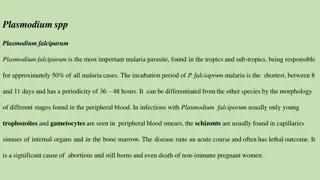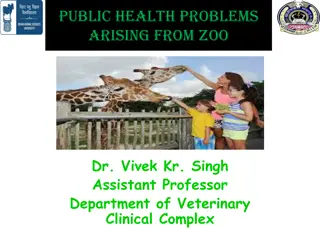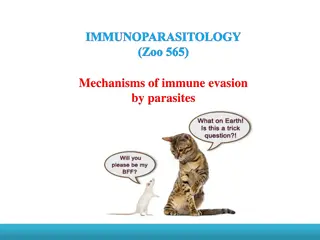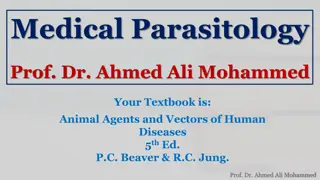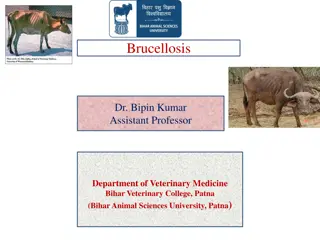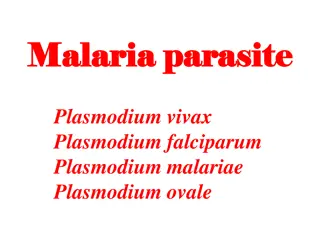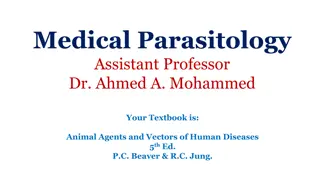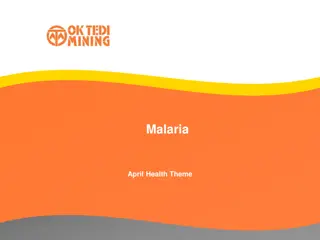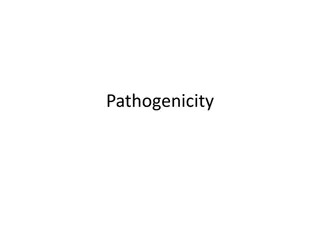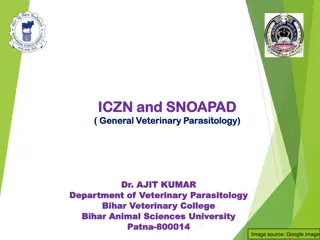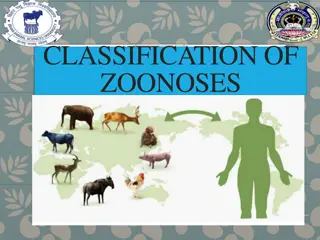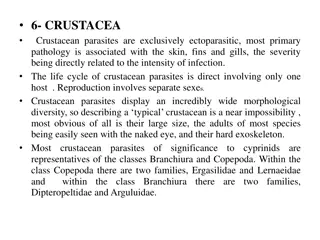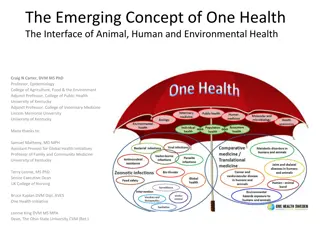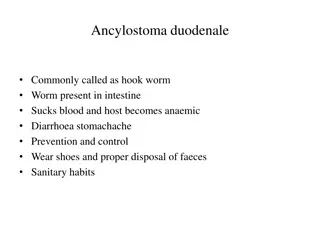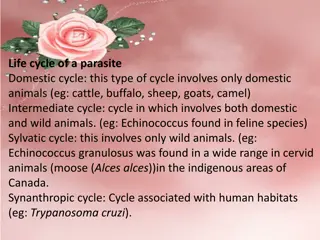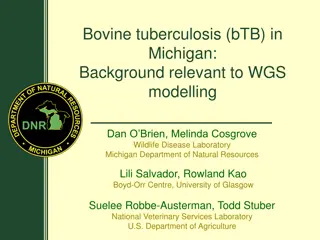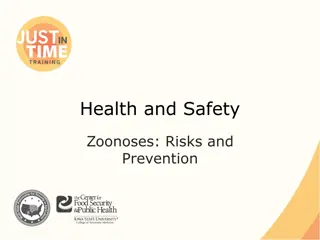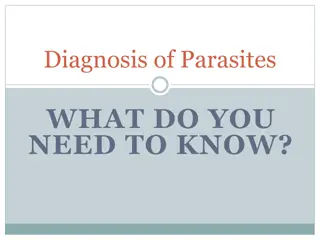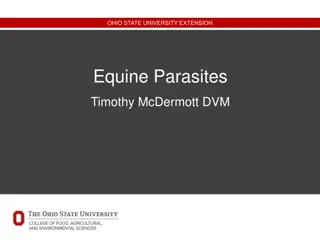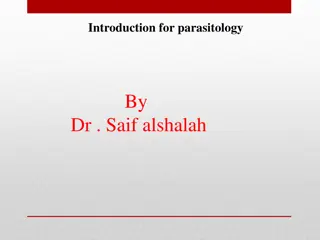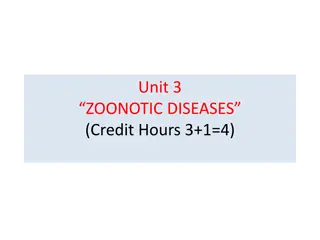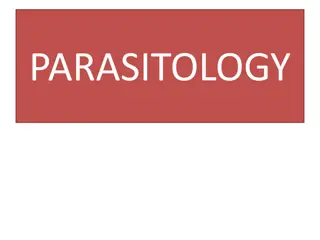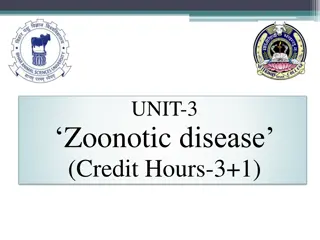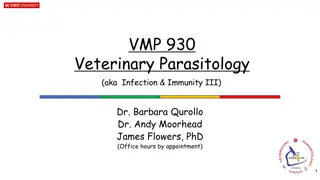Overview of Plasmodium falciparum and Plasmodium vivax Malaria Parasites
Plasmodium falciparum is the most significant malaria parasite, responsible for about 50% of cases, with a short incubation period and distinct morphology in blood smears. It causes severe symptoms and complications, affecting various organs. In contrast, Plasmodium vivax is the most common malaria
2 views • 7 slides
Understanding the Hookworm Superfamily Ancylostomatoidea
The superfamily Ancylostomatoidea includes blood-feeding parasites like hookworms, with important species such as Ancylostoma caninum in dogs and Ancylostoma duodenale in humans. These parasites have a complex lifecycle involving transmission through the environment and development within the host.
0 views • 31 slides
The Origin of Viruses: Theories and Evidence
Viruses are acellular parasites with a complex replication mechanism. Studies on their origin present challenges due to the lack of fossils. Three main hypotheses include regressive, cellular origin, and co-evolution. The regressive hypothesis suggests viruses originated from complex ancestors that
2 views • 25 slides
Adaptations in Helminth Parasites: Structural and Morphological Changes
Helminth parasites exhibit adaptations for successful living within hosts, involving structural modifications such as degeneration and new organ formation. Parasitism has evolved over time, leading to a dependent relationship between parasites and hosts. The adaptations in locomotory, digestive, and
1 views • 19 slides
Enhancing Zoonotic Disease Risk Communication in Public Health Emergencies
Explore the significance of adopting a One Health approach to zoonotic disease risk assessment and communication in the context of emergency health situations. The session emphasizes core capacities required by the International Health Regulations (IHR) 2005, effective risk communication processes,
2 views • 13 slides
Understanding Public Health Risks Associated with Zoos and Wild Animals
Zoos and wildlife parks serve as hubs for public recreation and education but can also pose public health risks due to potential transmission of zoonotic diseases by veterinarians who work closely with wild animals. Approximately 61% of infectious agents affecting humans are zoonotic in nature, with
0 views • 15 slides
Mechanisms of Immune Evasion by Parasites in Immunoparasitology
Understanding how parasites evade the immune system of their hosts is crucial in the field of immunoparasitology. Parasites have developed various strategies such as anatomical seclusion, antigenic variation, and intracellular living to avoid host immune responses. Examples include Plasmodium within
0 views • 26 slides
Understanding Parasitism in Medical Parasitology by Prof. Dr. Ahmed Ali Mohammed
Prof. Dr. Ahmed Ali Mohammed delves into the intriguing world of parasitism, exploring the complex relationships between parasites and hosts. He explains the various types of relationships in parasitology, such as symbiosis, mutualism, commensalism, and parasitism, shedding light on how parasites in
0 views • 23 slides
Understanding Brucellosis: A Zoonotic Disease Impacting Animals and Humans
Brucellosis, caused by the genus Brucella, is a zoonotic disease affecting animals like goats, sheep, cattle, and humans. It is primarily transmitted through contact with infected animals or ingestion of their products. The disease manifests in various forms like Mediterranean fever and can lead to
0 views • 13 slides
Understanding Malaria Parasites and Their Life Cycle
Malaria parasites, including Plasmodium vivax, falciparum, malariae, and ovale, exhibit an alternation of generations phenomenon with a life cycle involving asexual and sexual phases. These parasites require both vertebrate and invertebrate hosts for development, with maturation stages involving gam
0 views • 30 slides
Understanding Parasitic Relationships in Medical Parasitology
Medical Parasitology delves into the intricate relationships between parasites and their hosts, encompassing symbiosis, mutualism, commensalism, and parasitism. The success of a parasite hinges on achieving a delicate balance with its host, avoiding expulsion or harm. Various types of parasites are
0 views • 12 slides
Understanding Malaria: Causes, Symptoms, and Prevention
Malaria is an infectious disease caused by the Plasmodium parasite, transmitted through the bite of a female Anopheles mosquito. There are four types of Plasmodium parasites, with Plasmodium falciparum being the most severe. Malaria incidence globally has seen millions of cases with significant mort
9 views • 14 slides
Understanding Pathogenicity in Infectious Diseases and Parasitism
Pathogenicity refers to the ability of a pathogen to cause disease in plants, humans, and animals. Infectious diseases and parasitism play key roles in the spread and development of epidemics. Parasites can hinder the normal growth of plants by extracting nutrients, while different types of parasite
0 views • 5 slides
Understanding Naming Rules in Veterinary Parasitology
Explore the essential rules and regulations defined by the International Code for Zoological Nomenclature (ICZN) in the field of General Veterinary Parasitology. Learn about the nomenclature of parasites, scientific naming conventions for genera and species, and the classification of parasites in th
1 views • 14 slides
Understanding the Classification of Zoonoses
Zoonoses can be categorized based on etiological agents, transmission cycles, and reservoir hosts. Etiological agents include bacteria, viruses, rickettsia, fungi, and parasites. Transmission cycles vary between direct zoonoses, cyclozoonoses, and metazoonoses. Understanding these classifications is
0 views • 18 slides
Zoonotic Diseases in Mongolia: A One Health Perspective
High risk of zoonosis in Mongolia is evident due to various factors such as livestock practices, wildlife diseases, and environmental changes. The National Center for Zoonotic Diseases in Mongolia plays a crucial role in studying, preventing, and raising awareness about over 160 zoonotic infectious
0 views • 13 slides
Immune Responses to Parasitic Infections and Evasive Strategies by Protozoan and Helminth Parasites
Parasitic infections pose complex challenges to the immune system due to the diverse nature of parasites, including protozoans and helminths. Protozoan parasites move between arthropod vectors and mammalian hosts, requiring both humoral and cell-mediated immune responses. Meanwhile, helminths, as mu
0 views • 15 slides
Understanding Foodborne Illness: Causes and Symptoms
Foodborne illnesses are diseases transmitted to humans through contaminated food, causing symptoms like nausea, vomiting, stomach cramps, fever, and diarrhea. These illnesses are mainly caused by pathogenic microorganisms such as bacteria, viruses, and parasites, often spread through mishandling of
0 views • 10 slides
Understanding Parasitic Lifecycles and Evolution in Biology
Explore the intricate world of parasites and their lifecycles, from Protists to Bacteria, understanding how parasitism is a successful survival strategy. Discover the diversity of parasites, their lifecycle complexities, and the importance of multiple hosts in parasite development through examples l
0 views • 6 slides
Crustacean Parasites in Fish: Understanding Argulosis and Its Impact
Crustacean parasites, such as Argulus spp., can cause argulosis in fish, leading to skin, fin, and gill pathology. The life cycle of these parasites involves one host, with separate sexes for reproduction. Argulosis symptoms include behavioral abnormalities, irritation, and skin lesions, potentially
0 views • 22 slides
Understanding Echinococcosis: Symptoms, Transmission, and Treatment
Echinococcosis, a zoonotic disease caused by tapeworm parasites, has various forms such as cystic and alveolar echinococcosis. The disease is transmitted to humans through contaminated soil, water, or food. Diagnosis involves imaging techniques and serologic tests. Treatment options include surgery,
0 views • 9 slides
Understanding Sarcocystis Parasites in Veterinary Parasitology
Veterinary Parasitology delves into the study of Sarcocystis parasites, focusing on their morphology, life cycle, and impact on hosts. The Sarcocystidae family, including species like Sarcocystis hominis and S. suihominis, are examined for their pathogenicity in carnivores and herbivores, shedding l
1 views • 11 slides
Understanding Parasitism in Veterinary Medicine
Parasites can cause significant harm to animals by interfering with normal physiological processes. They can be ectoparasites (external) like mites and ticks, or endoparasites (internal) such as roundworms and hookworms. Diagnosis of parasitism is crucial for effective treatment, with common species
0 views • 27 slides
Understanding Brucellae: Characteristics and Infection Routes
Brucellae are intracellular parasites causing brucellosis in humans, characterized by acute bacteremia followed by a chronic phase. The four zoonotic species are B. melitensis, B. abortus, B. suis, and B. canis. Their morphology, growth characteristics, antigenic structure, and common infection rout
0 views • 18 slides
Understanding Human Parasites: Laboratory Testing, Neglected Tropical Diseases, and More
Explore the world of human parasites through laboratory testing for intestinal, blood, and tissue parasites. Learn about neglected tropical diseases, common parasitic disease exposures, Texas notifiable conditions, and additional parasites to be aware of. Traditional parasitology techniques involvin
0 views • 19 slides
Understanding One Health and Zoonotic Diseases
Dive into the concept of One Health, which emphasizes the interconnectedness of animal, human, and environmental health. Explore the mission, leadership, and impact of the One Health Initiative, supported by major organizations like WHO, WOAH, and FAO. Learn about zoonotic diseases, how they are tra
0 views • 38 slides
Common Human Intestinal Parasites and Their Prevention
Ancylostoma duodenale, Wuchereria bancrofti, Dracunculus medinensis, and Enterobius vermicularis are common human parasites causing various diseases. From hookworms to pinworms, these parasites can lead to anemia, filariasis, elephantiasis, and inflammation. Proper sanitation and hygiene practices,
0 views • 9 slides
Understanding Zoonotic Hepatitis A Virus Infections
Zoonotic hepatitis A virus infections primarily affect humans and nonhuman primates, with transmission occurring through fecal-oral route. This article delves into the reservoir, mode of transmission, clinical signs, and diagnosis of hepatitis A, shedding light on its impact on both species. Nonhuma
0 views • 22 slides
Understanding the Complexities of Parasite Life Cycles and Host Interactions
Parasites exhibit diverse life cycles and behaviors, with cycles ranging from domestic to sylvatic environments. Factors influencing parasite diseases include host specificity, immunity, and host-parasite interactions. Parasitism can alter host behavior, impacting ecological dynamics. Immunology pla
0 views • 9 slides
Bovine Tuberculosis (bTB) in Michigan: Insights and Findings
Background information on the prevalence and zoonotic cases of bovine tuberculosis in Michigan, USA, highlighting statistics on infected livestock herds and wild deer over the years. The extent of zoonotic bTB cases and the achievable elimination of bTB from cattle are discussed, along with accredit
0 views • 24 slides
Molecular Investigation of Zoonotic Pathogens in Rodents of Iran
This presentation explores the molecular investigation of zoonotic pathogens such as Coxiella burnetii, Bartonella, Rickettsia, Ehrlichia, Brucella, and Borrelia in rodents of Iran. It discusses the background of zoonotic disease pathogens, disease reservoirs, characteristics of Coxiella burnetii, v
0 views • 58 slides
Understanding Zoonotic Diseases and Prevention Strategies
Zoonotic diseases pose a risk as they can be transmitted from animals to humans under natural conditions. Awareness of transmission routes is crucial. Direct contact, ingestion, aerosol, and indirect transmission through fomites or vectors are common means of spreading these diseases. Animals may no
0 views • 15 slides
Understanding Parasite Diagnosis: What You Need to Know
Explore the essential information for diagnosing parasites, including their appearance, size, morphology, and where they are typically found. Learn how to identify parasites based on their characteristics, such as size, shape, and the host species they infect. Discover key factors involved in diagno
0 views • 12 slides
Understanding Equine Parasites: A Comprehensive Guide by Ohio State University Extension
Explore the intricate world of equine parasites with a detailed guide provided by Ohio State University Extension. Learn about internal and external parasites, common signs of infestation, fecal testing techniques, and specific types like strongyles and roundworms. Discover the importance of proper
0 views • 24 slides
Understanding Parasitology: An Introductory Overview by Dr. Saif alshalah
Parasitology, as elucidated by Dr. Saif alshalah, delves into the science of parasites and their impact. This discipline encompasses medical parasitology, the study of parasitic agents causing diseases in humans. The definition and classification of parasites based on their nature, association with
0 views • 12 slides
Understanding Internal Parasites of Livestock
Internal parasites of livestock, such as roundworms, tapeworms, and flukes, can have a significant impact on the health and productivity of animals. These parasites live within the internal organs of livestock, causing various symptoms and affecting different species. Roundworms, like stomach worms,
0 views • 30 slides
Understanding Paragonimiasis: A Zoonotic Disease
Paragonimiasis is a zoonotic disease caused by the Paragonimus lung fluke, primarily transmitted to humans through consumption of raw or undercooked crabs or crayfish. The disease can lead to various symptoms ranging from mild cough and abdominal pain to more severe cases affecting the central nervo
0 views • 9 slides
Understanding Parasitology: The Study of Organisms Living on or within Hosts
Parasitology is the study of parasites, which are organisms that live on or within a host and derive nutrients from them without benefiting the host. Parasites can be classified as ectoparasites or endoparasites based on their location in or on the host. Hosts play a crucial role in the life cycle o
0 views • 23 slides
Understanding Zoonotic Diseases and Mycoses
Zoonotic diseases, caused by fungi, have the potential to affect both animals and humans and are often transmitted through various environmental factors. These diseases can lead to a range of conditions affecting different organs and structures of the body. Mycoses, such as superficial and systemic
0 views • 19 slides
Veterinary Parasitology Course Syllabus
This veterinary parasitology course covers major parasites of domestic animals, their life cycles, clinical signs, diagnostic techniques, treatment plans, and zoonotic concerns. The syllabus includes recommended texts, schedule of lectures and exams, lab group decisions, and details on examinations
0 views • 10 slides
